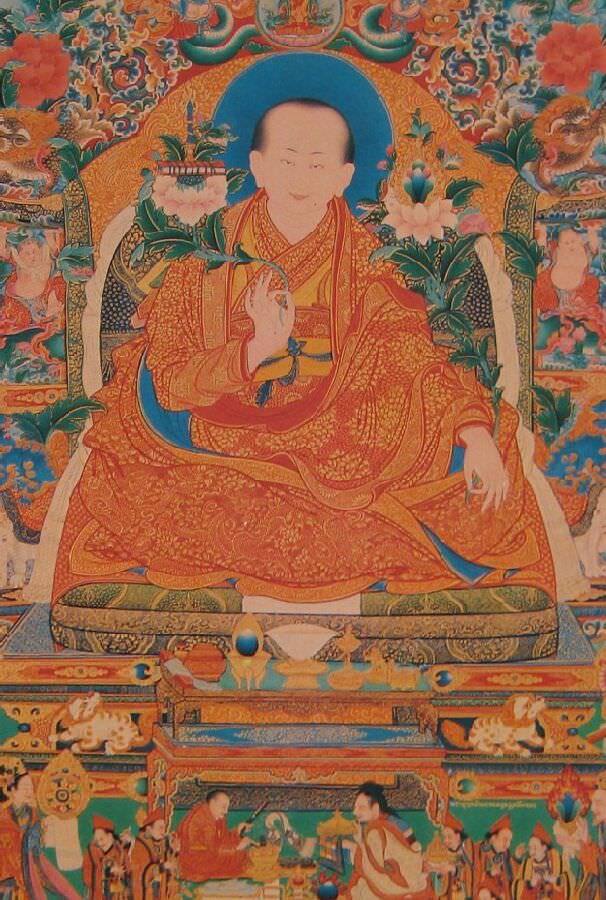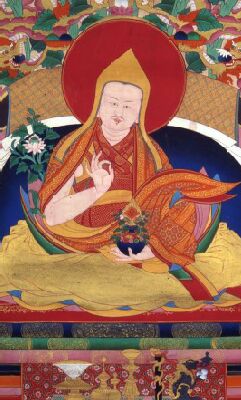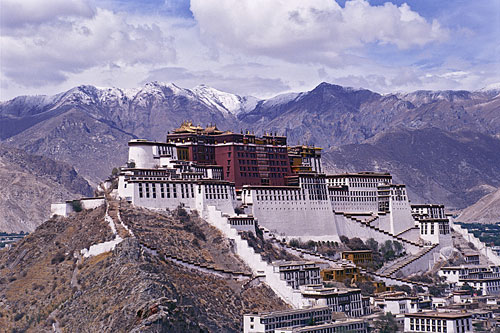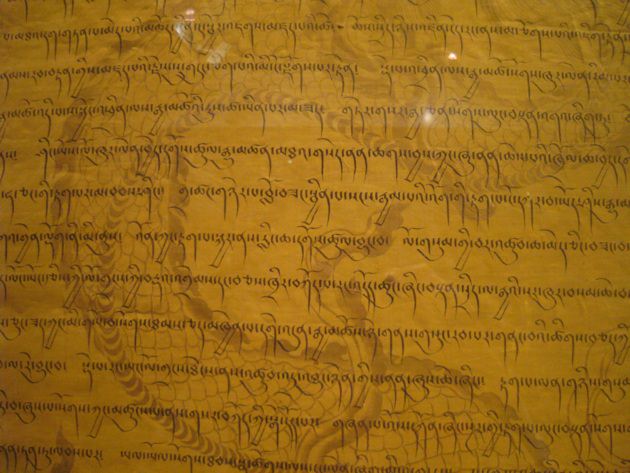The Dalai Lama’s recent announcement of his planned retirement was not well received by China’s Foreign Ministry, whose spokeswoman described it as an attempt “to deceive the international community.” Many assumed this to be a reference to the fact that even after the Tibetan leader gives up his official position within the exile Tibetan administration, he will continue to travel, give speeches, and be a symbolic leader to Tibetans, a source of considerable frustration for Beijing. But Chinese officials also appear to be worried about something rather more obscure: a little-known seventeenth-century precedent in which the retirement of a Dalai Lama concealed a convoluted plot to prevent China from choosing his successor.
For this is not the first time that the Dalai Lama of Tibet has issued a decree announcing that a younger, largely unknown man is to take over as the political leader of the Tibetan people. It happened before—in 1679. To explain why this detail of history matters to the Chinese government requires a little background.
Until the Chinese army took over his country in 1950, leading him to flee into exile nine years later, the current Dalai Lama, who is the fourteenth of his line, held political authority over Tibet. Historically, Dalai Lamas were not always recognized as having that power: the first four Dalai Lamas only had spiritual status as leading Buddhist teachers of their time. It was the Fifth Dalai Lama who was first given the authority to rule Tibet, following its invasion by a Mongol warlord who was a ferocious supporter of the Dalai Lama’s sect and so placed him on the throne, when he was twenty-five years old. That was in the Water-Horse year of the 11th Cycle, or 1642. The Fifth seems to have been extraordinarily capable, because under his rule, backed up by the Mongols’ army, Tibet expanded into a vast and unified state covering most of the Tibetan plateau, with an organized bureaucracy, tax, and census system.
But it is the events at the end of the Fifth Dalai Lama’s reign that seem to be of particular concern to Chinese analysts at the moment. After 43 years of rule, the Fifth announced that he had appointed a young Tibetan as the Sde-ba or head of the government, a position similar to that of regent. He had appointed such officials before, but now he was near the end of his life and was returning to a contemplative existence as a meditator and a scholar (he wrote at least thirty works in his lifetime, including some on the art of government). In 1679, he issued a decree announcing the appointment of the official, called Sangye Gyatso, who later became one of Tibet’s most famous writers.
Because of its exceptional importance, the Fifth signed the decree not just with his name or seal, but with the full imprint of both his hands, dipped in gold and stamped upon the document. The decree was made into a scroll, 12 feet long, calligraphed on yellow silk with a painting of a curling dragon holding a wish-fulfilling jewel in its claws underneath the text, protector deities and snow-lions at its foot, and a portrait of the Dalai Lama at its head. It is one of the marks of Tibet’s national tragedy that this scroll, a pinnacle of Tibetan decorative art and political history, is no longer in Tibet: it is in exile too, in New York, having been carried out by a Tibetan family when they fled from Tibet fifty years ago.
The Fifth went even further to emphasize the special nature of this decree: he had it painted onto a wall of the Potala Palace in Lhasa, at the top of the triple stairs that lead to the eastern entrance of the White Palace of the Potala, where it would be seen by every visitor. No other administrative or political document in Tibetan history is known to have received this treatment, and the mural is still there, since the building was one of the very few monuments in Tibet spared during the Cultural Revolution. The golden handprints have survived as well.
This centuries-old decree does not seem at first glance to have much similarity to the Fourteenth Dalai Lama’s plans today, except that both concern the appointment of officials to replace him in his secular responsibilities. The Fourteenth’s decree is a very modern document—it describes his decision to democratize his government in Dharamsala, India, and instructs the exiles’ parliament to change their constitution so that, in the future, Dalai Lamas will no longer hold any political power. Instead, the political leader of the exile Tibetans is expected to be an elected Prime Minister, and on March 20, exile Tibetans went to the polls to choose who will hold that post (the three final candidates are all laymen educated in the United States or Britain or working there; the election results are expected in late April, after all the diaspora votes have been counted).
Advertisement
But from Beijing’s perspective, the democratization of the exile government is a minor detail. For them, the Fourteenth Dalai Lama’s underlying objective appears similar to the Fifth’s: not just to create a robust government that will survive the death of a charismatic leader, but also to forestall Chinese involvement in the selection of the next Dalai Lama. Indeed, it is no secret that the Fourteenth’s democratic initiative is designed to create an exile administration that will function independently until a settlement is reached with China, in case, as seems increasingly likely, that does not happen before his death—or that its most important task will be to find and establish the next Dalai Lama without interference from Beijing.
However, in their reading, some Chinese analysts see a more elaborate machination in play. At the time of the 1679 decree, the situation was roughly similar to today: a powerful China—then under the newly established Qing dynasty—was actively claiming overlordship of Tibet, and the Dalai Lama was in his final years. His new Regent, Sangye Gyatso, was only twenty-six years old, and so was likely to live long enough to handle by himself the fifteen-year-long process of finding and bringing up the next Dalai Lama. But the Fifth did not rely on this alone to ensure that his succession would remain in Tibetan hands: he had another, hidden strategy. It is this that has led to heightened concern in Beijing today.
For three years after the double-handprint decree of 1679 had been announced, when the Fifth had completely withdrawn from public life and knew his end was near, he gave Sangye Gyatso additional instructions: the Regent was to keep his coming death a secret. It was a ruse the Fifth had probably learned from the Bhutanese, who had done the same on the death of their leader, also a lama, thirty-one years earlier.
When the Fifth died in 1682 at the age of sixty-five, Sangye Gyatso duly informed the public that the Dalai Lama was in retreat. On the rare occasions when important visitors were allowed an audience, he enlisted an elderly monk of similar age and appearance to pretend to be the Fifth; the monk wore a large eye-shade, much like the current Dalai Lama, albeit for different reasons.
The deception was so effective that it was fourteen years before the Chinese Emperor realized he had been duped, and then only because some Mongolian prisoners of war mentioned reports they had heard in Lhasa that the Dalai Lama had died more than a decade earlier. By then the next Dalai Lama had been identified, educated, and established: a succession crisis had largely been avoided. The Qing had been denied any say over the selection of the Sixth Dalai Lama, thus taking away a fundamental part of their claim to overlordship. “You, Regent!” thundered the Emperor Kangxi in a 1696 edict to Sangye Gyatso, “You are nothing except an administrator working for the Dalai Lama, you were elevated to be the ‘King of Tibet’ by us! …This news should have been communicated to us directly!”
Hence the concern in some quarters of Beijing that the current Dalai Lama might be similarly using his retirement to prevent China from selecting his spiritual successor and thus reinforcing its claim to sovereignty over Tibet. Control of the selection of lamas is so important to that claim that the current Chinese leadership passed a law in 2007 ordaining that only it has the authority to choose the reincarnation of a Dalai Lama, or of any other lama. (Like their seventeenth-century predecessors, China’s leaders show relatively little interest in political leaders among Tibetans; it is the spiritual leaders who are seen as significant and powerful.) So we should not be surprised that, weeks before the Dalai Lama’s announcement about his retirement plans, elite analysts within the Chinese government were tasked with determining whether he might also be planning to go into retreat in order to conceal his eventual death. The level of concern was sufficient that even foreign views were sought, and I was approached discreetly for my opinion (which was negative); no doubt others were asked as well.
To a secular rationalist this might seem far-fetched: how could any modern leader hide his own death? But major decisions in modern Chinese politics are often made on the basis of historical antecedents, sometimes with positive results and at other times with tragic ones. When Mao briefly allowed Tibet almost total autonomy in the 1950s, it was probably in part because he knew from historians that it had never been a province or an integral part of China in the past. When a Tibetan child was forcibly installed by Beijing to be the 11th Panchen Lama in 1995, officials were following the example of Chinese Nationalists, who in 1949 had imposed their own choice as the previous incumbent. And again, when Jiang Zemin made a brutal decision to annihilate the basically harmless Falungong cult in 1999, it is believed that he saw it as analogous to the religious movement that had started the Taiping Rebellion and nearly toppled the Qing in the mid-19th century.
Advertisement

Courtesy of Himalayan Art Resources
Sangye Gyatso (1653–1705), the Tibetan Regent who concealed the Fifth Dalai Lama’s death
Given this deep vein of historicism and mutual suspicion, it becomes easier to understand the Chinese government’s hypersensitive reading of the events of 1679. Indeed, when the Tibetan Drama Troupe in Lhasa made Budala gong mishi (“The Secret History of the Potala Palace”), an epic 1989 film about the Fifth Dalai Lama’s 1679 decree and Sangye Gyatso’s successful deception of the Qing Emperors, it was immediately banned, and it has never been shown publicly in China. And eight years later, the Party Secretary of Tibet, Chen Kuiyuan, issued an unprecedented declaration that Sangye Gyatso was henceforth to be considered a “separatist chieftain,” though he carefully avoided reminding readers of the reasons. Positive mention of the Regent has been banned in Tibet or elsewhere in China ever since.
The Party, it seems, does not forget the past, or at least not episodes in which its imperial predecessors were outmaneuvred by Tibetans, lamas, or their appointees. This is by no means the only perspective found among analysts in Beijing, much of whose work is no doubt of great astuteness. But it provides an indication of the centuries of mistrust that must be overcome before China and the Tibetan leadership can resolve their differences.






